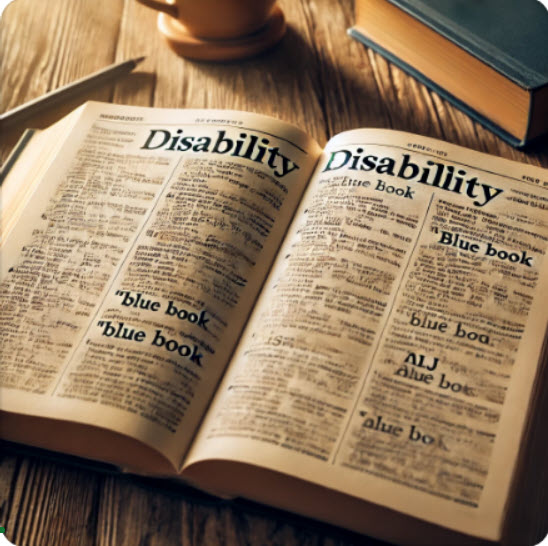Applying for Social Security Disability (SSDI) benefits is like learning a new language. With so many unfamiliar terms, acronyms, and processes, it’s easy to feel overwhelmed. After decades of representing Social Security Disability clients, we’ve created this easy-to-understand dictionary of standard Social Security Disability terms. Whether applying for the first time or navigating an appeal, this guide will help you feel more confident.
A
- Activities of Daily Living (ADLs): These are basic daily tasks like eating, bathing, dressing, and moving around. If you struggle with ADLs, it could support your SSDI claim. The SSA (Social Security Administration) may ask you to complete an ADL questionnaire to assess your abilities.
- Administrative Law Judge (ALJ): Think of the ALJ as a referee for your SSDI appeal. They review evidence, hear testimony, and decide whether you qualify for benefits.
- ALJ Hearing: This is a formal meeting with an Administrative Law Judge, often the most critical step in the appeals process. The ALJ looks at your case independently and decides whether the denial of your benefits should be overturned.
- Appeal: If your SSDI application is denied, don’t panic—you can appeal the decision. Appeals have multiple steps, including:
- Reconsideration (a second look at your application).
- A hearing with an ALJ.
- A review by the Appeals Council.
- Filing a lawsuit in Federal Court if necessary.
- Attorney’s Fees: You never pay an attorney to represent you. If the attorney assists in winning your case and you are awarded Back Pay or Back benefits, Social Security will withhold 25% of the back pay lump sum payment, capped at $9200, and send it to your attorney.
B
- Back Pay: If your claim is approved, you might receive “back pay,” or “back due benefits” which includes benefits owed to you from the time you became eligible. This often starts five months after your disability began and can go back up to 12 months before your application date.
- Blue Book: The SSA’s guide to qualifying disabilities lists medical conditions severe enough to qualify for SSDI potentially. It’s officially called “Disability Evaluation Under Social Security.”
C
- Credits: Sometimes called “work credits,” these are earned as you work and pay Social Security taxes. You need a certain number of credits to qualify for SSDI, depending on your age when you became disabled.
D
- Date of Filing: The day you officially submit your SSDI application. This date is essential for determining your eligibility and benefits timeline.
- Disability: SSDI defines disability as:
- A medical condition preventing you from working for at least 12 months or expected to result in death.
- A condition is severe enough that you can’t do your past job or adjust to new work.
- Disability Examiner: The person who reviews your application and recommends whether you meet the disability requirements.
F
- Five-Step Sequential Evaluation: This is the process the SSA uses to decide if you qualify for benefits. Each step asks a specific question about your condition, work history, and ability to perform other jobs.
O
- Office of Disability Adjudication and Review (ODAR): This office handles hearings and decisions for SSDI appeals. If you request a hearing, your case will go to the ODAR nearest you.
P
- Past Relevant Work: The SSA looks at jobs you’ve held in the past 15 years to see if you can still do them despite your disability. They consider the skills required and the physical/mental demands of those jobs.
R
- Request for Hearing: If your request for reconsideration is denied, the next step is to ask for a hearing with an ALJ. This is often where claims have the best chance of approval.
- Residual Functional Capacity (RFC): This measures what kind of work you can still do, if any, based on your condition. It’s classified as sedentary, light, medium, heavy, or very heavy work.
S
- Social Security Disability Insurance (SSDI): This program provides benefits to people who have worked and paid Social Security taxes but can no longer work due to a disability.
- Substantial Gainful Activity (SGA): This is the level of work and income the SSA uses to determine if you’re disabled. If you earn above the SGA limit, you may not qualify for SSDI.
V
- Vocational Factors: These include your age, education, and work experience. The SSA combines these with your medical condition to decide if you can adjust to other work.
W
- Waiting Period: There’s a mandatory five-month waiting period after your disability begins before you can receive SSDI benefits. For most people, this means benefits don’t start until nearly six months after the onset of the disability.
We understand the SSDI process can feel overwhelming, but you don’t have to navigate it alone. If you’re feeling stuck or have questions, our experienced attorneys at Hoffman, Larin & Agnetti are here to help you every step of the way. Our office represents disability cases throughout the State of Florida.
Call us at 305-653-5555 , Text us at 305-653-1515, email us at [email protected], or fill out the form on this page, and our Social Security Disability attorneys will contact you.
Call us today for a free consultation.





